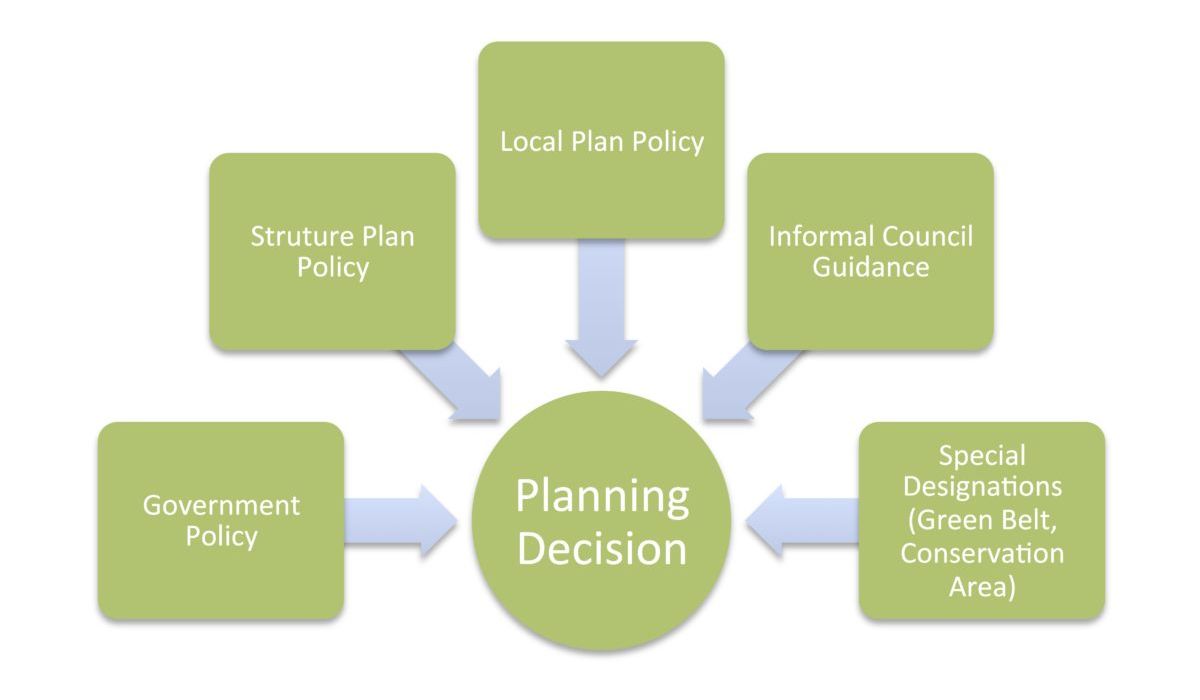
How Planning Decisions are Made
What determines whether planning permission is given or refused?
Some elements are not relevant to planning, but it is difficult to specify. However, where possible, all applications should relate in some way to the property purpose or its current development.
The following summaries factors affecting planning decisions and factors that should not affect planning decisions:
Affecting planning decision:
- Government planning advice
- Structure Plan policy
- Local Plan policy
- Informal council guidance
- Special designations (Green Belt, Conservation Area, Area of Outstanding Natural Beauty/National Scenic Area)
- Size and shape of site
- Size and position of buildings
- Relationship to other property
- Pattern of Development
- Site layout
- Amount of garden area
- Trees and hedges
- Parking and turning space
- Drainage
- Overlooking and over shadowing
- Noise and disturbance
- Blocking adjoining windows
- Character of area
- Affect on setting
- Design and appearance
- Affect on countryside
- Type of materials
- Compatible with existing building
- Public rights of way
- Rights of light
Should not affect planning decision:
- Structural stability
- Stability of adjoining buildings
- Safety of materials
- Boundary and neighbour disputes
- Private right of way
- Access to maintain other property
- Personal circumstances
- Identity of applicant
- How long applicant lived in area
- Motives of applicant
- Future intentions
- Financial viability
- Loss of private views
- Values of property
- Supervision and standard of work
- Disruption during construction
- Precedent
- Benefits unrelated to proposal
Objections from local residents put pressure on local council’s, but should not be the sole reason for refusal. However, what would be considered an acceptable planning application could be refused due to local residents objections.
Sanctions are in place to monitor councils. Should an application be unreasonably refused, councils could be forced to pay the applicant’s cost of going to appeal.
In extreme and very rare cases, it has been known for council individuals to accept monitory gifts or favours in return for their support. This is naturally a criminal offence and prosecutions are made from time to time. Planning permission can add immense value to land, so the possibility will always be present.
The law stipulates the basis for deciding planning applications. Approved planning policies set out in development plans must follow by all councils and also inspectors on appeal unless ‘material considerations’ indicate otherwise.
Material considerations, although not limited to, can include:
- Overlooking/loss of privacy
- Loss of light or overshadowing
- Parking
- Highway safety
- Traffic
- Noise
- Effect on listed building and conservation area
- Layout and density of building
- Design, appearance and materials
- Government policy
- Disabled persons’ access
- Proposals in the Development Plan
- Previous planning decisions (including appeal decisions)
- Nature conservation
Roll of Planning Policies
Structure Plans and Local Plans documents set out planning policies. Welsh and English councils have Unitary Development Plans (UPDs) and contained in one document. We find it simpler to use the term ‘Local Plan’. Structure Plans are drawn up by county councils or by groups of unitary councils and cover whole county areas. This includes new building, expanding towns and protection of the countryside.
Local Plan policies can be general and apply throughout the area (standards for building design). They can relate to specific areas such as Conservation Areas and apply to developments such as house extensions. Local Plans give guidance of how a site should be developed (for example new homes).
Sections covered in Local Plan policies are relevant to residential developments and likely to be included within:
- Housing – amount and location of new housing, housing types, design and conversions
- Build Environment – new buildings, extensions and alterations, landscaping
- Conservation – building design and materials, building in Conservation Areas, work on Listed Buildings
- Countryside – restraint on building outside urban areas, building in Green Belts, Areas of Outstanding Natural Beauty, National Scenic Areas, agricultural dwellings
An application will be primarily judged through the Policies within the Structure and Local Plan (UPD). However, this is not always as simple as it might be and policies can contradict each other, point in different directions and be open to different interpretations. Planning policies are the starting point for decisions, but as we have already advised, material considerations have to be taken into account.
Government Policy and Advice on Planning
The government has it own national planning policies set out in circulars and in England, Planning Policy Guidance Notes. Scotland is National Planning Policy Guidelines and Planning Advice Notes. Northern Ireland, Planning Policy Statements and Policy Guidance Advice Notes. Technical Advice Notes applies to Wales.
Councils’ informal planning policy
Usually, councils will produce other statements and leaflets setting out their views and guidance. This is in addition to Structure and Local Plans. This may include advice on design and layout, trees and development or car parking and access. This advice can be helpful, but does not have the same status as Local Plan policies. They are mainly intended to give guidance and should not be applied rigidly by councils.
Effects of special designations
Special designations are within planning and can apply to individual buildings or areas of land. A majority will be:
- Conservation Areas – parts of town or villages with special historic or architectural character
- Listed Buildings – individual buildings or structures with particular historic or architectural merit
- Tree Preservation Orders – protection given to individual trees, groups of trees or whole woodlands
- Areas of Outstanding Natural Beauty or National Scenic Areas in Scotland – areas of particularly attractive countryside.
A council would need to know how a development would impact on these designated areas.
Influence of Planning History
Decisions can be influenced either way if there are previous planning applications or existing buildings and uses on the site.
If previous permissions have been granted, refusal should not be an issue. Unless a building has historic or architectural importance, a replacement will generally be granted.
Granting planning permission for something that replaces an undesirable site would provide a helpful solution. However, if your request is similar to previous planning permissions that have been refused, it is unlikely to succeed. Permissions for a replacement or extension larger than the existing building can also be restricted.
Appeals, although not always clear, are significant if an inspector’s decision is disputed. Explanations from previous refusal/s or permissions granted will listed. Versions are often disputed between applicants and councils.
List of practical factors influencing decisions:
- Shape and size of the existing site
- Topography
- Ground conditions
- Archaeological remains
- Effect on existing buildings
- Boundaries
- Services
- Trees
- Wildlife
- Access
- Car Parking
- Rights of Way
- Surrounding Area
- Neighbours



